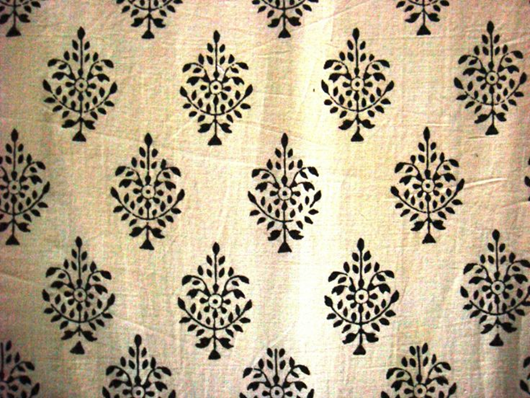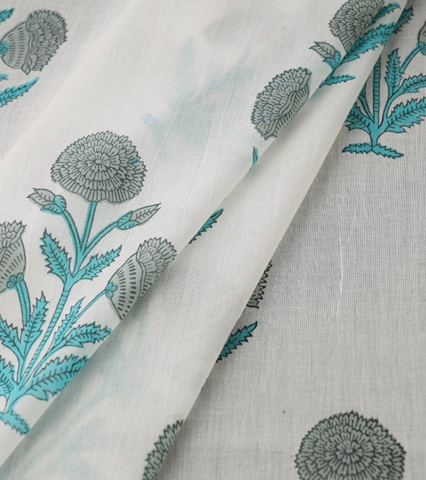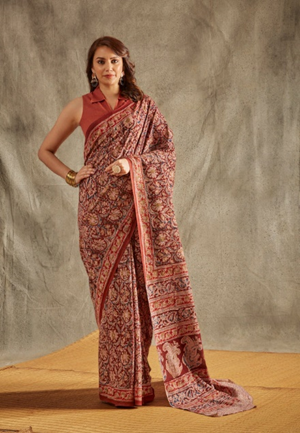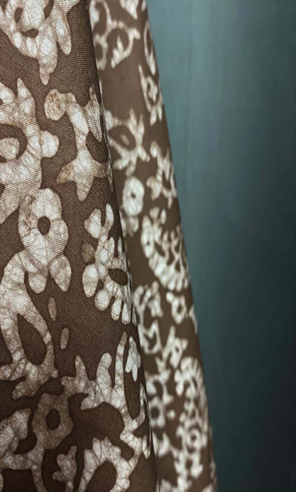
Block printing is a lovely, traditional method that involves hand-stamping elaborate images into fabric. It's a method that blends talent, dedication, and creativity to produce unique and colourful works. Every print has its own story and is like an artwork. Block printing originated in Asia, especially in China and India. Particularly in places like Rajasthan and Gujarat, the method gained popularity in India for its vibrant colours and unique patterns. By transferring this ability from one generation to the next, artisans have preserved the beauty of block printing. Block printing is unique in the fast fashion industry due to its charm and genuineness. Today, people across the world value the work and expertise that go into making block-printed goods. They consider it to be a work of art that embodies a rich cultural history rather than simply clothing.
There are several unique types of block printing, each with its own techniques, styles, and regional influences. Here are some of the most popular types of block printing, primarily from India:
- Bagri Block Print - Originating in the Rajasthani village of Bagri, bagri block printing is a traditional textile printing technique renowned for its organic appearance and natural beauty. This traditional method combines vibrant designs and natural dyes made from local materials including flowers, roots, and plants. The colours are frequently black, red, blue, and yellow. The first step in the process is to prepare the fabric for dying by treating it with a mixture of turmeric and Fuller's earth (clay), which intensifies the colours and extends their durability.
The fabric is then stamped with elaborate motifs, such as geometric, floral, and paisley patterns, by artisans using hand-carved wooden blocks. Natural dyes and the unique "mud-resist" technique, which gives the prints a rustic, handmade feel, make every Bagru print https://www.parthi.shop/shop/e-com-cm-012-cotton-malmal-in-yellow-color-384#attribute_values=89 a celebration of craftsmanship and legacy
- Sanganer Block Print - Originating in the Rajasthani village of Sanganer, Sanganer Block Printing is renowned for its elaborate floral patterns and vibrant colours on light backgrounds, typically pastel or white. Delicate, nature-inspired designs like flowers, leaves, vines, and occasionally animals are highlighted in this block printing approach, giving the prints a beautiful, exquisite appearance. The precise lines and symmetrical patterns that characterize Sanganeri prints are achieved by artisans using carefully cut blocks of wood to create these intricate motifs. In the past, natural dyes were used, and the fabric would strongly display hues like red, black, and yellow. Sanganeri designs are famous in India and beyond because of their timeless appeal and fresh, airy appearance, which is ideal for summer attire such as sarees and dupattas, thanks to the light backdrop and soft, brilliant colours.

- Dabu Block Print - Rajasthan is the birthplace of dabu block printing, a unique, traditional mud-resist dyeing method renowned for its deep, earthy appeal and rich textures. Using hand-carved wooden blocks, sections of the cloth are treated with a paste consisting of clay, gum, and lime at the start of this time-consuming procedure. The paste is then held in place by sprinkling sawdust on top, which forms a resist that stops the dye from leaking into certain areas of the fabric. The fabric is dipped in dye after drying, usually indigo for a classic look. When the mud is removed, complex patterns in clashing hues are shown. To layer colors and give the artwork depth, several rounds of resist-dying and washing are occasionally carried out. The final prints are striking and have a distinctive rustic texture that highlights Indian craftsmanship's skill and legacy.
- Ajrakh Block Print - Ajrakh block printing is a sophisticated, traditional method that originated in Gujarat and Rajasthan. It is well-known for its rich, organic colours and symmetrical, detailed designs. It is a time-consuming procedure that frequently takes days to finish and involves several steps of dying, printing, and washing. After first giving the fabric a basic wash, artisans utilize intricately carved wooden blocks to print layers of motifs, which typically include geometric shapes, floral patterns, and symmetrical designs. Natural dyes made from plants and minerals, such as madder for reds and indigo for deep blues, are used to colour each layer. One of Ajrakh's distinctive features is its double-sided printing, which is a sign of skilful craftsmanship and appears on both sides of the cloth. Ajrakh https://www.parthi.shop/shop/e-com-cm-008-cotton-malmal-in-brown-color-381#attribute_values=108 are valued for their modification, depth, and classic beauty because of the intricate, fascinating patterns created by the careful placement.

- Kalamkari Block Print - Kalamkari block printing is an esteemed textile art style, particularly in the areas of Tamil Nadu and Andhra Pradesh. The term "Kalamkari" originates from "kalam" (which means pen) and "kari" (which signifies craftsmanship), highlighting the historical application of a pen-style tool to embed complex, hand-drawn elements into the patterns. This artistic expression distinctively merges block printing with hand painting to create vibrant, story-telling fabrics that frequently display intricate floral designs and peacock themes, alongside imagery drawn from Hindu myths and epics like the Ramayana and Mahabharata. Cotton serves as the main fabric for Kalamkari prints; it is soft, absorbent, and long-lasting, making it a perfect option for both hand-painting and block printing. Craftspeople employ natural dyes derived from materials such as iron and indigo to create an attractive, earthy colour scheme that reflects the enduring charm of Kalamkari. Every item combines accuracy and creativity, beginning with a block-printed design outline and then meticulously hand-painted to incorporate elaborate details. Kalamkari fabrics feature a unique aesthetic, characterized by vibrant and expressive designs that showcase cultural traditions and the artistry of Indian craftsmen.
- Batik Block Print –The textile art of batik block printing, which is mostly done in West Bengal, India, is distinguished by its distinctive wax-resist dying method. Using wooden blocks carved with elaborate patterns, melted wax is applied to the fabric. By acting as a resistor, the wax keeps the dye from soaking into specific parts of the fabric. After applying the wax, only the non-waxed portions of the cloth are coloured by dipping it in dye. Beautiful, contrasting patterns are revealed when the wax is removed after dyeing. To create layered graphics with deep depth, the technique is occasionally repeated using different colours. The distinctive "crackle" appearance, which happens when the wax partially fractures and lets tiny dye lines show through, is one of the distinguishing characteristics of batik printing. Natural fabrics like cotton and silk are highly absorbent, which is essential for the dye to penetrate evenly and for the wax to be absorbed properly during the printing process This demonstrates a fusion of ancient techniques and the beauty of nature, giving Batik fabric a distinctive, textured appearance that seems natural and beautiful.

Block printing is an interesting and ancient art form that links us to centuries of workmanship and tradition. Every type of block printing, whether it's the rich designs of Ajrakh, the motifs of Sanganer, or the natural tones of Bagri, tells a story and captures the history and culture of its area. By providing our clients with more than simply a piece of clothing, Parthi honours the beauty of block-printed sarees. Every occasion is enhanced by the warmth, uniqueness, and classic beauty of these handcrafted prints.
.